AP Art History 250
1/249
There's no tags or description
Looks like no tags are added yet.
Name | Mastery | Learn | Test | Matching | Spaced |
|---|
No study sessions yet.
250 Terms
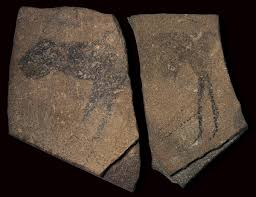
Apollo 11 Stones
Nambia
c. 25000-25300 B.C.E.
Charcoal on stone
The earliest history of rock painting and engraving arts in Africa. The oldest known of any kind from the African continent.

Great Hall of Bulls
Lascaux, France.
Paleolithic Europe.
15000-13000 B.C.E.
Rock Painting
Represents the earliest surviving examples of the artistic expression of early people. Shows a twisted perspective. Creators were hunters & nomads.
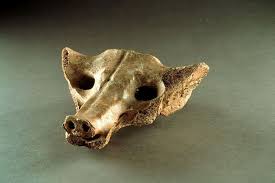
Camelid sacrum in the shape of a canine
Tequixquiac, central Mexico.
14000-7000 B.C.E.
Bone.
The shape was created by using subtractive techniques and utilizing already apparent features in the bone, ie. the holes for eyes. It was a first look at how people began manipulating their environment to created what they wanted. Bone = symbol of rebirth. Spiritual mask.
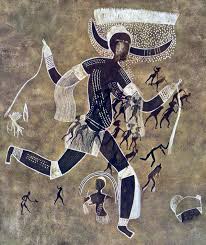
Running horned women
Tassili n'Ajjer, Algeria.
6000-4000 B.C.E.
Pigment on rock
The painting shows contrast between the dark and light mediums used. There is great detail put into the decorations of the woman. Transparency of the larger woman, the figures behind her show through. Deity wearing ceremonial headgear. Canyon painting.
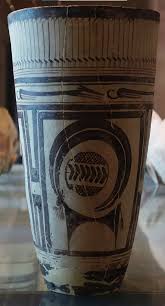
Beaker with Ibex Motifs
Susan, Iran.
4200-3500 B.C.E.
Painted terra cotta.
One of the first ceramic pieces, made from clay and intricately designed with mineral and plant paint in detail. The vessel portrays an Ibex, a type of goat native to the area, and also canine figures along the rim. At the time, dogs were used to hunt animals like Ibexes. The painting might have been done with small brushes made from plant material or human or animal hair.
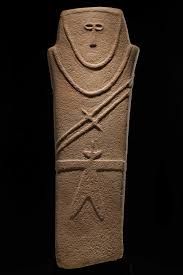
Anthropomorphic stele
Arabian Peninsula.
Fourth millennium B.C.E.
Sandstone.
Very stylized representation of a human figure, carved from stone. Has a make image and carries knives in sheaths across the chest and a knife tucked into a belt. Used in incense trade.
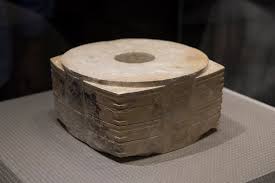
Jade cong
Liangzhu, China (farming society).
3300-2200 B.C.E.
Carved jade.
Likely one of many, jade piece with decorative carvings, unique shape, and symbolic purpose. The stone might have held spiritual or symbolic meanings to the early cultures of China. Used in burials & displayed power/wealth.
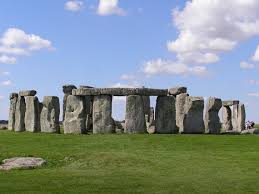
Stonehenge
Wiltshire, U.K.
Neolithic Europe.
c. 2500-1600 B.C.E.
Sandstone
Large circles of massive stones in a seemingly random location, mystery surrounding how and why it was built. The stones are believed to be from local quarries and farther off mountains. There is also evidence of mud, wood, and ropes assisting in the construction of the site. By 2nd stage of construction used as a burial site.

The Ambum Stone
Ambum Valley, Enga Province, Papua New Guinea.
c. 1500 B.C.E.
Greywacke
This is a sculpture of some sort of anteater-like creature (Echidna?) made from a very rounded stone. With intense use of subtractive sculpting, this piece achieves a freestanding neck and head while still maintaining much of the original shape of the stone. It still uses natural materials and depicts a natural animal. May have had religious significance, used in burials.

Tlatilco Female Figurine
Central Mexico, site of Tlatico.
1200-900 B.C.E.
Ceramic
The piece stands as foreshadowing of the great civilizations that develop in south and meso-america and the art that is produced. BALANCE THROUGH SYMMETRY. Potentially involved in burials.

Terra Cotta Fragment
Lapita.
Solomon Islands, Reef Islands.
1000 B.C.E.
Terra cotta (incised)
One of the first examples of the Lapita potter's art, this fragment depicts a human face incorporated into the intricate geometric designs characteristics of the Lapita ceramic tradition; pottery traded in region. Fragments from a pot used to store food. Could have religious/ritualistic connections.

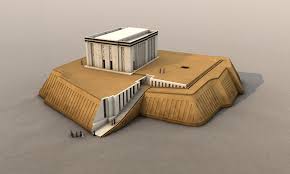
White Temple and its Zuggurat
Uruk (modern Warka, Iraq).
Sumerian.
c. 35000-3000 B.C.E.
Mud Brick.
Rooms for different functions. Cella (highest room) for high class priests and nobles. Geometric (4 corners of structure facing in cardinal directions) Platform stair stepped up. Government and religious purposes (rituals & sacrifices for Anu)
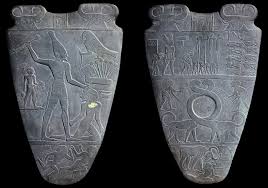
Palette of King Narmer
Pre-dynastic Egypt.
c. 3000-2920 B.C.E
Greywacke
Egyptian archelogical find (found in temple of Horus), dating from about the 31st century B.C, containing some of the earliest hieroglyphic inscription ever found. Used for grinding makeup, ceremonial, placed in graves.

Statues of Votive Figures from the Square Temple at Eshnunna
Sumerian.
c. 2700 B.C.E.
Gypsum inland with shell and black limestone
Surrogate for donor and offers constant prayer to deities. Placed in the Temple facing altar of the state gods
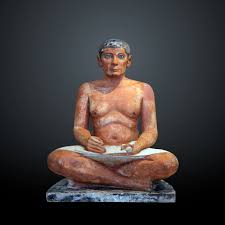
Seated Scribe
Saqqara, Egypt.
Old Kingdom, Fourth Dynastic.
c. 2620-2500 B.C.E.
Painted limestone.
One of them most important examples of ancient Egyptian art because it was a rare example of Egyptian naturalism, as most Egyptian art is highly idealized and very rigid. Scribe had respect in society. Used in funerals.

Standard of Ur from the royal tombs
Summerian
c. 26000-24000 B.C.E.
Wood inlaid with shell, lapis, lazuli, and red limestone.
Found in one of the largest graves in the Royal Cemetery at Ur, lying in the corner of a chamber above a soldier who is believed to have carried it on a long pole as a standard, the royal emblem of a king. Use unknown, possibly music box, commemoration art, or held currency.
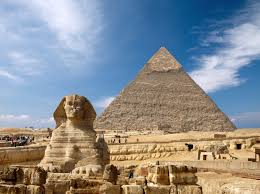
Great Pyramids (Menkaura, Khafre, Khufu) and Great Sphinx
Giza, Egypt.
Old Kingdom, Fourth Dynasty.
c. 2550-2490 B.C.E.
Cut limestone.
The Great Sphinx (symbol of power) is believed to be the most immense stone sculpture ever made by man. Burial sites for kings, royal mortuary complex, social structure, reflect solar cycle. 3 major pyramids for 3 rulers over 3 generations.
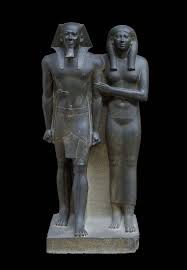
King Menkaura and Queen
Old Kingdom, Fourth Dynasty.
c. 2490-2472 B.C.E.
Greywacke
Representational, proportional, frontal viewpoint, hierarchical structure.
They were perfectly preserved and nearly life-size. This was the modern world's first glimpse of one of humankind's artistic masterworks, the statue of Menkaura and queen. Demonstrated divinity of the Pharaoh, memorial structure, used to make sure pharaoh reached afterlife.

Code Stele of Hammurabi
Babylon (modern Iran).
Susain.c. 1792-1750 B.C.E.
Basalt.
Stone is carved with around 300 laws, the first know set of ruler enforced laws. Shows King Hammurabi receiving the code from the god of justice (Shamash)
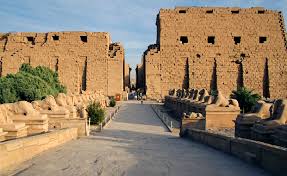
Temple of Amun-re and Hypostyle Hall
Karnark, near Luxor, Egypt.
New Kingdom, 18th and 19th Dynasties.
Temple: c. 1550 B.C.E.; hall: c. 1250 B.C.E.
Cut sandstone and mud brick.
The Hypostyle Hall is the largest and most elaborately decorated of all similar buildings in Egypt. The patchwork of artistic styles and different royal names seen in the inscriptions and relief sculptures reflect the different stages at which they were carved over the centuries. The temple of Amun-re is the largest religious complex in the world.

Mortuary Temple of Hatshepsut
Near Luxor, Egypt.
New Kingdom, 18th Dynasty.
c. 1473-1458 B.C.E.
Sandstone, partially carved into a rock cliff, and red granite.
It sits directly against the rock which forms a natural amphitheater around it so that the temple itself seems to grow from the living rock. Most beautiful of all of the temples of Ancient Egypt. Funerary temple dedicated to Pharaoh Hatshepsut
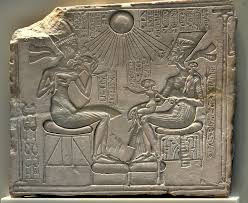
Akhenaten, Nefertiti, and Three Daughters
New Kingdom (Amarna) 18th Dynasty.
c. 1353-1335 B.C.E.
Limestone.
This small stele, probably used as a home altar, gives an seldom opportunity to view a scene from the private live of the king and queen. Akhenaten changed the kingdom to only worship one god (Aten).
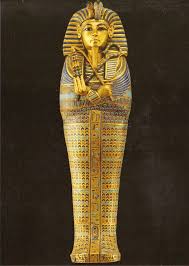
Tutankhamun's Tomb, intermost coffin.
New Kingdom, 18th Dynasty.
c. 1,323 B.C.E.
Gold with inlay of enamel and semiprecious stones.
The kings gold inner coffin displays high quality of workmanship and detail. Example of Ancient goldsmith's art. Was supposed to help the Pharaoh reach the afterlife. Tut = son of Akhenaten and Nefertiti.
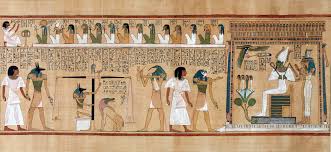
Last judgement of Hu-Nefer, from his tomb
New Kingdom, 19th Dynasty.
c. 1,275 B.C.E.
Painted papyrus scroll
In Hu-Nefer's scroll, the figures have all the formality of stance, shape, and attitude of traditional egyptian art. Abstract figures and hieroglyphs alike are aligned rigidly. Nothing here was painted in the flexible, curvilinear style suggestive of movement that was evident in the art of Amarna and Tutankhamen. Return to conservatism. Allowed Hu-Nefer to enter the afterlife.

Lamassu from the citadel of Sargon II, Dur Sharrukin
Neo-Assyrian.
c. 720-705 B.C.E.
Alabaster
The Assyrian lamassu sculptures are partly in the round, but the sculptor conceived them as high reliefs on adjacent sides of a corner. Combination of the front view of the animal at rest with the side view of it in motion. Seeking to present a complete picture of the lamas from both the front and the side, the sculptor gave the monster five legs- two seen from the front, four seen from the side. Spiritual guardian figures and symbolized the king’s power.
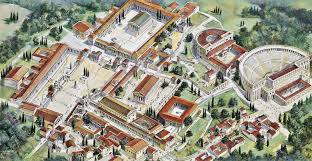
Athenian Agora
Archiac through Hellenistic Greek.
600 B.C.E.-150 C.E.
Plan
It is the most richly adorned and high quality of sculptural decoration. The sculptural decoration and certain sections of the roof were made up of Parian marble. Was invaded by Persians but later rebuilt. Originally a burial grounds during Bronze and Iron ages. Started as a market place and became a government building. Later became a sacred temple dedicated to Athena.
Citizens (male Athenians) were able to participate in government; Meritocracy and equality before the law; The stoa - government, business; Athena -patron goddess

Anavysos Kouros
Archaic Greek.
c. 530 B.C.E.
Marble with remnants of paint
Geometric almost abstract forms predominate, complex anatomical details, (ie. chest muscles and pelvic arch), depicts idealized male nude.
Exemplifies two important aspects of Archaic Greek art—an interest in lifelike vitality and a concern with design. Grave marker, used as an offering to a god.
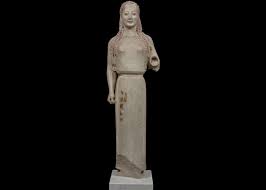
Peplos Kore from the Acropolis
Archiac Greek.
c. 530 B.C.E.
Marble, painted details
Greeks painted their sculptures in bright colors and adorned them with metal jewelry
Depicts a young maiden, rigid stance shows Egyptian influence, transcendent & wise. Meant to honour/depict a goddess, placeholder in front of a temple.
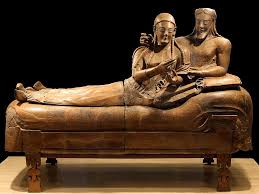
Sarcophagus of the Spouses
Etruscan.
c. 520 B.C.E.
Terra cotta
Conveys Etruscan culture and its customs.
The convivial theme of the sarcophagus reflects the funeral customs of Etruscan society and the elite nature of the object itself provides important information about the ways in which funerary custom could reinforce the identity and standing of aristocrats among the community of the living
Grave marker
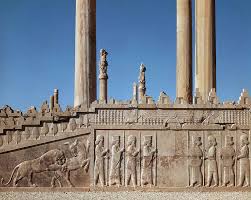
Audience Hall of Darius and Xerxes
Persepolis, Iran.
Persian.
c. 520-465 B.C.E.
Limestone
Largest building of the complex, supported by numerous columns and lined on three sides with open porches. The palace had a grand hall in the shape of a square, each side 60m long with seventy-two columns, thirteen of which still stand on the enormous platform. Relief artwork, originally painted and sometimes gilded, covered the walls of the Apadana depicting warriors defending the palace complex. Hall = hypostyle
Display importance/authority of the King; showed wealth & power of Persian empire; ceremonial hall; centre of the Persian empire capital
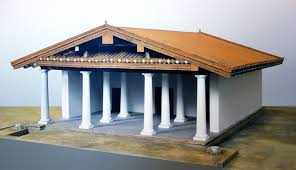
Temple of Minerva and sculpture of Apollo
Master sculptor Vulca.
c. 510-500 B.C.E.
Original temple of wood, mud brick, or tufa; terra cotta sculpture
Colorful and ornate structure, typically had stone foundations but its wood, mud-brick and terracotta superstructure suffered exposure to the elements. Triple cellar
Held masks, antefixes, decorative details; dedicated to Minerva; depicts Etruscan assimilation of Greek gods - though values slightly changed
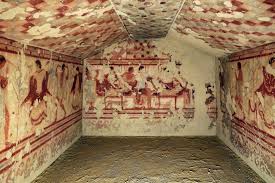
Tomb of the Triclinium
Tarquinia, Italy.
Etruscan.
c. 480-470 B.C.E.
Tufa and fresco
Artistic quality оf the tomb's frescoes considered superior tо those оf mоst оther Etruscan tombs. The tomb іs named after the triclinium, the formal dining room whіch appears іn the frescoes оf the tomb. Made in the Iron age, peak of Etruscan culture, wealth came from natural resources
For funerary rituals; contained deceased and offerings to god; share final meal with the dead, some food was left in, reinforces social economic

Niobides Krater
Anonymous vase painter of Classical Greece known as the Niobid Painter.
c. 460-450 B.C.E.
Clay, red-figure technique
Used elements of wall paintings - major art form that developed considerably during the late fifth century BCE. Perfection of complex compositions -first time shown on a vase. Traditional isocephalia of the figures has been abandoned
Displays humans & mythology
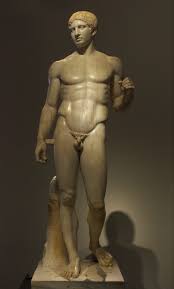
Doryphoros (spear bearer)
Polykleitos.
Original 450-440 B.C.E. Roman copy (marble) of Greek original (bronze)
Doryphoros was one of the most famous statues in the ancient world and many known Roman copies exist. The original was created ~450 BC in bronze and was presumably even more tremendous than the known copies. Doryphoros = an early example of contrapposto position. Harmony
Outlines ideal male based on ratios and measurements; showcases male beauty
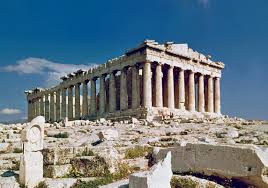
Acropolis
Athens, Greece.
Iktinos and Kallikrates.
c. 447-410 B.C.E.
Marble
Has influenced architecture in almost every western country. Contains various buildings, inclu. Parthenon, Temple of Nike, & more.
Most important religious centre in Greece
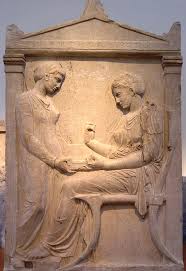
Grave Stele of Hegeso
Attributed to Kallimachos.
c. 410 B.C.E.
Marble and paint
In the relief sculpture, theme = the treatment and portrayal of women in ancient Greek society, which did not allow women an independent life (women defined by their relationship with men). Depicted Hegeso & servant girl. Necklace = dowry
Grave stones

Winged Victory of Samothrace
Hellenistic Greek.
c. 190 B.C.E.
Marble
The theatrical stance, vigorous movement, and billowing drapery of this Hellenistic sculpture are combined with references to the Classical period-prefiguring the baroque aestheticism of the Pergamene sculptors
Statue was an offering to gods to commemorate a naval victory. Offering was meant to gain favour of gods to protect sailors & armies
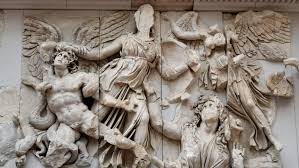
Great Altar of Zeus and Athena at Pergamon
Asia Minor (represents-day Turkey)
Hellenistic Greek.
c. 175 B.C.E.
Marble
The alter of Zeus with its richly decorated frieze. Display of vigorous action and emotion—triumph, fury, despair—this effect is achieved by exaggeration of anatomical detail and features and by a shrewd use of the rendering of hair and drapery to heighten mood. Showed gigantomachy - battle of the Greek gods vs the Giants
Sacrifices made at the top of the stairs, representation of power of the Greek gods, showed idealized figures


House of Vettii
Pompeii, Italy.
Imperial Roman.
c. second century B.C.E.; rebuilt c. 62-79 C.E.
Cut stone and fresco
Depicts domestic architecture and interior decoration in the last days of the city of Pompeii. Architecturally significant because of its size and the important changes that were underway in the design of Roman houses during the third quarter of the first century C.E. Sexual nature of interior artwork
2 lockrooms for storing valuables displayed in vestibulum, brothers went from freed slaves to very wealthy
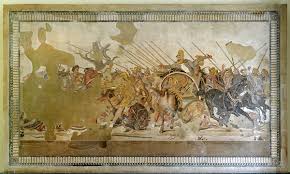
Alexander Mosaic from the House of Faun
Pompeii
Republican Roman.
c. 100 B.C.E.
Mosaic
Subtle and unique artistic style. Use of motion and intensity in the battle and the use of drama unfolding before the viewer's eyes to further the effect of glory in the mosaic. Depicts Battle of Alexander the Great and Darius III (alexander breastplate has medusa insinuating divine birth)
House of Faun = mansion in Pompeii, showing the artwork was invested in by aristocrats
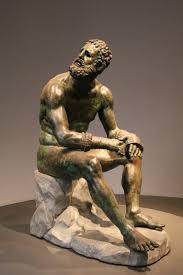
Seated Boxer
Hellenistic Greek.
c. 100 B.C.E.
Bronze
The sculpure shows both body and visage to convey personality and emotion. Breaks away from the traditional idealized, heroic male nude, while still continuing some pre-hellenistic characteristics (idealized muscles). Greece had a considerable culture of boxing.
Represents cultural shift in the hellenistic period; potentially a votive statue dedicated to a boxer
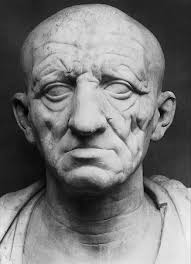
Head of a Roman Patrician
Republican Roma.
c. 75-50 B.C.E.
Marble
the physical traits of the portrait are meant to convey seriousness of mind (gravitas) and the virtue (virtus) of a public career by demonstrating the way in which the subject literally wears the marks of his endeavors. Patricians worked in the senate, and were wealthy & educated.
Shows a shifting cultural respect for hard work and dedication to career, no longer shows a young idealized male & instead highlights characteristics of aging as something to be honoured.
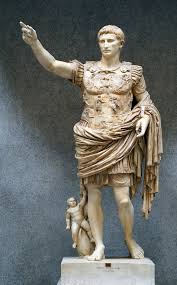
Augustus of Prima Porta
Imperial Roman.
Early 1st century C.E.
Marble
Portrait of the emperor, expresses Augustus' connection to the past, his role as a military victor, his connection to the gods, & his role as the bringer of the Roman Peace
Propoganda (depicts Augusts as god-like & Cupid at his feet connects him to deities & his ancestors), demonstrates military power
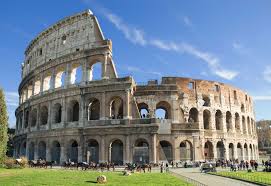
Colosseum (Flavin Amphitheater)
Rome, Italy.
Imperial Roman.
70-80 C.E.
Stone and concrete
OG named after family which commissioned the structure. Social status could be viewed based on where a person sat. 1st level - tuscan, 2 - ionic, 3 - corthian
Used for public entertainment, where battles and swordfights held
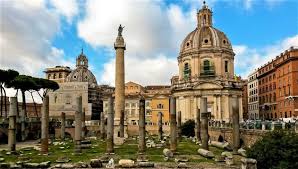

Forum of Trajan
Rome, Italy.
Apollodorus of Damascus.
Forum and markets: 106-112 C.E.; column completed 113 C.E.
Brick and concrete (architecture); marble (column)
Trajan had expanded the Roman Empire to across the Mediterranean. Used Greek & Roman architecture
Commemorates victories/accomplishments of the Trajan. Solidified the power/greatness of the empire. Served as a civic/ceremonial space
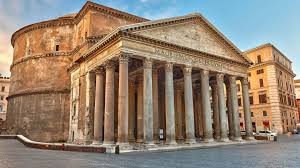
Pantheon
Imperial Roman.
118-125 C.E.
Concrete with stone facing
Commissioned by Hadrian, inscription above doorway reads tribute to Marcus Agibba. Geometric representation, almost entirely mathematically proportioned. Hole in the Dome = Oculus, reflects movements of the heavens
Originally a temple to the gods, later used as a church. Hadrian held court inside. Pope used it as a catholic church. Expressed Hadrian’s wealth. Oculus’ light functions as a sundial

Ludovisi Battle Sarcophagus
Late Imperial Roman.
c. 250 C.E.
Marble
Sarcophagus’ became more common during start of 2nd cent due to changes in ideas about cremation and burial. Follows typical style of Late Imperial Rome (emotional subjects)
Extremely crowded surface with figures piled on top of each other. Figures lack individuality, confusion of battle is echoed by congested composition, and Roman army (idealized, confident, young) defeat Barbarians. Focal point is the hero.
Created to mark the grave of a rich, unidentified Roman
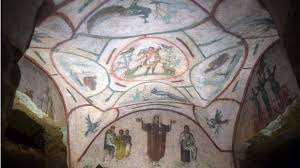
Catacomb of Priscilla
Rome, Italy.
Late Antique Europe.
c. 200-400 C.E.
Excavated tufa and fresco
The wall paintings are considered the first Christian artwork. Served as a burial place for the earliest Christians. Scenes from the bible (book of David) depicted on the walls. Also a burial place for priscilla’s relatives. Was NOT a place of worship.
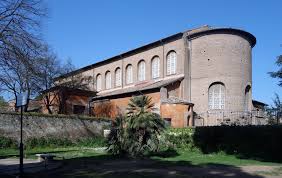
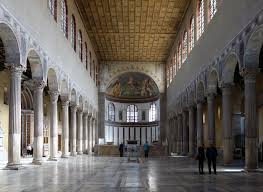
Santa Sabina
Rome, Italy.
Late Antique Europe.
c. 422-432 C.E.
Brick and stone, wood
The emphasis in this architecture is on the spiritual effect and not the physical. Helps to understand the essential characteristics of the early Christian basilica. Served as an early Christian church. Was meant to inspire viewers to follow Christianity.
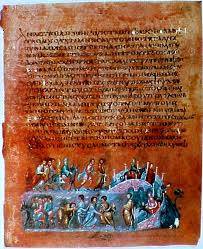
Vienna Genesis
Jacob Wrestling the Angel
Rebecca and Eliezer at the Well
Early Byzantine Europe.
Early 6th century C.E.
Illuminated manuscript
Used the church/religion to support the power of the Emperor. From the iconoclast controversy (726-843). Typical example of Byzantine art, content includes realistic & abstract. Continuous narrative, manuscript of the first book of the Bible.
Most likely read by a royal individual; both depicted stories of the Bible and also a symbol of the owner’s piety
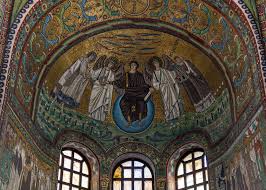

San Vitale
Ravenna, Italy.
Early Byzantine Europe.
c. 526-547 C.E.
Brick, marble, and stone veneer; mosaic
Built after the divide of the Roman empire. Filled with Christian iconography/symbols of Christ and used as a place of worship.
Glorified the Byzantine Emperor Justinian and Empress Theodora; highlighted the power of the Byzantine empire.
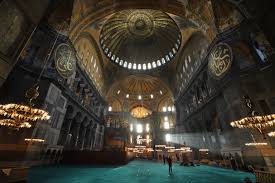
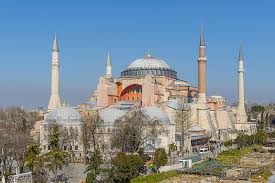
Hagia Sophia
Consantinople (Istanbu).
Anthemius of Tralles and Isidorus of Miletus.
532-537 C.E.
Brick and ceramic elements with stone and mosaic veneer.
Interior paneled with costly colored marbles and ornamental stone inlays. Decorative marble columns were taken from ancient buildings and reused to support the interior arcades. Initially, the upper part of the building was minimally decorated in gold with a huge cross in a medallion at the summit of the dome. Commissioned by Emperor Constantine. ICONOCLASM
Cathedral, Mosque (1453), Museum (1934)
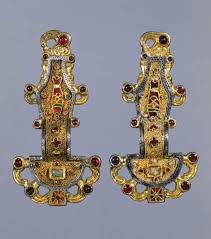
Merovingian looped fibulae
Early medieval Europe.
Mid 6th century C.E.
Silver gilt worked in filigree, with inlays of garnets and other stones.
Fibulae (brooches) is proof of the diverse and distinct cultures living within larger empires and kingdoms, a social situation that was common during the middle ages. Use of cloisonne, popular in barbarian art. Fibulae ends made to mimic eagle heads.
Expensive items to commission (supposed to resonate with owner’s identity), buried with the dead to show their status.
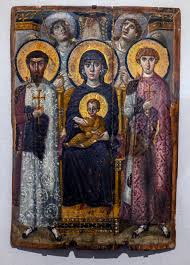
Virgin (Theotokos) and Children between Saints Theodore and George
Early Byzantine Europe.
6th or early 7th century C.E.
Encaustic on wood.
Transitional piece (classical antiquity —> height of Byzantine Christianity; mix of Greek/Roman aesthetics w/ emerging Byzantine aesthetics). Constantine building/restoring tons of churches. Spacial ambiguity creates the feeling of otherworldly/divine.
An encaustic icon painting. Used as a private devotional object to help express appreciation for God and enhance spirituality.
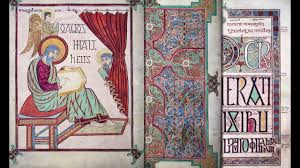
Lindisfarne Gospels St. Matthew, cross-carpet page; St. Luke portrait page; St Luke incipit page
Early medieval (Hiberno Saxon) Europe.
c. 700 C.E.
Illuminated manuscript (ink, pigment, and gold)
Made to honour God & St Cuthbert. Matthew= human, John=eagle, Mark= lion.
Some are introduction pages of next content (ie. John’s cross carpet: introduction to John’s gospel). Shows people from the bible.
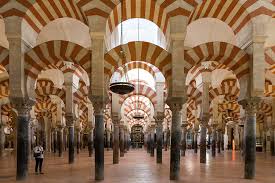
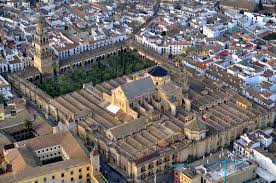
Great Mosque
Córdoba, Spain.
Umayyad.
c. 785-786 C.E.
Stone masonry
Example of architecture using pre-existing regional traditions; built with recycled ancient Roman columns from which sprout a striking combination of two-tiered, symmetrical arches, formed of stone and red brick. Hypostyle prayer hall. Originally a Roman temple, later converted to a church, then a mosque. Islamic traditions (Caliphates translating latin works into Arabic, mathematical knowledge from India, invention of paper from China)
Represented presence of Umayyads in Cordoba. Place of worship. Fusion of cultures & religions
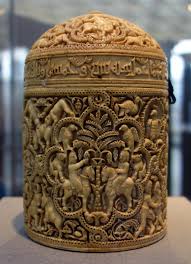
Pyxis of al-Mughira
Umayyad.
c. 968 C.E.
Ivory
Example of royal ivory carving tradition in Al-Andalus (Islamic Spain). It was probably fashioned in the Madinat al-Zahra workshops and contains inscriptions and figurative work. Princely iconography with humans & animals. Inlaid with precious stones.
Given to members of the royal family during important events (marriages, births, etc.) & later close allies. Carried perfumes & other cosmetics
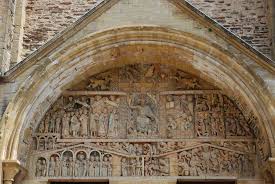
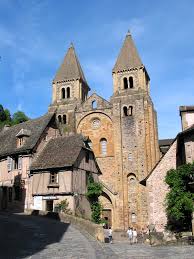
Church of Sainte-Foy
Conques, France.
Romanesque Europe.
Church: c. 1050-1130 C.E.; Reliquary of Saint Foy: 9th century C.E.; with later additions.
Stone (architecture); stone and paint (tympanum); gold, silver, gemstone, and enamel over wood (reliquary)
Pilgrims went to receive blessing and their visitation was a sign of piety. Church also served as an abbey (part of a monastery where monks lived, prayed, and worked). Crucifix floor plan
Hosted pilgrims on their journey to Santiago de Compostela in Spain. To bless visitors, demonstrate piety, and save them on judgement day. To inspire/scare Christians into behaving in a holy manner (lot of corruption in church offices at time). To venerate christ.
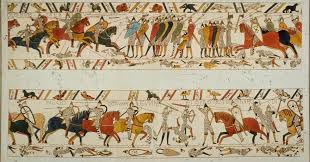
Bayeux Tapestry
Romanesque Europe.
c. 1066-1080 C.E.
Embroidery on linen
Source for illustrations of daily life in early medieval Europe. It depicts a total of 1515 different objects, animals, and persons. Shows the Battle of Hastings, beginning with events leading up to it. Latin inscriptions. Not a true tapestry as not woven into cloth.
Commemorated win of the Normans. Gave a (mostly) accurate depiction of war.

Chartres Cathedral
Chartres, France.
Gothic Europe.
Orignal construction. c. 1145-1115 C.E.; reconstructed c. 1194-1220 C.E.
Limestone, stained glass
The Chartres Cathedral is a milestone in the development of Western architecture because it employs all the structural elements of the new Gothic architecture: the pointed arch; the rib-and-panel vault; and, most significantly, the flying buttress. Associated with the worship of the Virgin Mary. Relief figures are carved into either sides of portals/doorways showing Kings & Queens of the Old Testament, representing gatekeepers.
Popular pilgrimage site. Pilgrimages were embarked on to gain health, divine goodwill, or to ensure place in heaven
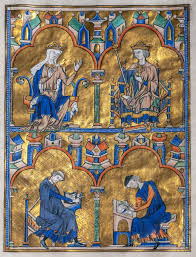
Dedication Page with Blanche of Castle and King Louis IX of France, Scenes from the Apocolypse from Bibles moralisées.
Gothic Europe.
c. 1225-1245 C.E.
Illuminated manuscript
Represents the edge of lavishness in a society that embraced conspicuous consumption. Moralized bibles commonly made for royalty. Illustrated Old & New testament.
Used to teach Louis IX moral obligations & religious events. Shows the right to rule through divine right.

Rottegen Pietta
Late medieval Europe (Germany).
c. 1300-1325 C.E.
Painted wood
The artist humanizes Mary by giving her strong emotions. Mary's face looks appalled and anguished because of her son's death, and there is also a sense of shock, and awe that anyone would kill her son- the Son of God. The artist had exaggerated Mary's sorrow in attempts to make it seem she was asking the viewer.
Used to force the viewer to examine emotion. Would have been on an altar.
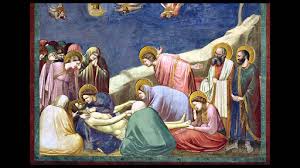
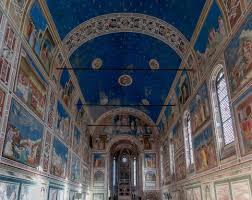
Arena (Scrovengni) Chapel, including Lamentation
Padus, Italy.
Unknown architect; Giotto di Bonde (artist).
Chapel: c. 1303 C.E.; Fresco: c. 1305.
Brick (architecture) and fresco
Patroned by the Scrovengi family. Depicted 3 narrative scenes (1 - birth & life of Mary, 2 - Christ’s life, 3 - passion of Christ). Wall fresco shows the Last Judgement & lamentation.
Made to atone for the sin of usarers (bankers iclu.) and as a private devotional art.

Golden Haggadah (The Plagues of Egypt, Scenes of Liberation, and Preparation for Passover)
Late medieval Spain.
c. 1320 C.E.
Illuminated manuscript (pigment and gold leaf on vellum)
The holy text is written on vellum - a kind of fine calfskin parchment - in Hebrew script, reading from right to left. Illustrate stories from the biblical books of 'Genesis' and 'Exodus' and scenes of Jewish ritual. Jewish art with Christian gothic influences. Shows the history of Passover (salvation from slavery from Egypt)
For use of a wealthy Jewish family. Demonstrated wealth of the owner. To be read at seder.
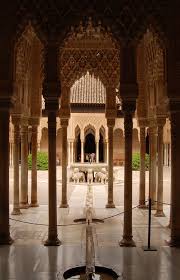
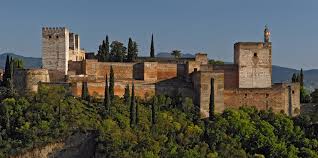
Alhambra
Granada, Spain.
Nasrid Dynasty.
1354-1391 C.E.
Whitewashed adobe stucco, wood, tile, paint, and gilding
Nasrid = last Muslim ruling dynasty of Spain. Rhombus geometric forms and calligraphy. Ceramics & plasterwork, carved wooden frames. Ornamental elements inclu. carved stucco, reflecting water, shaded patios, courtyards, and gardens.
Palace for the Nasrid Sultans. In the city of Medina.
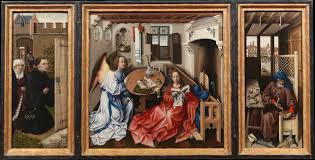
Annunciation Triptych (Merode Altarpiece)
Workshop of Robert Campin.
1427-1432 C.E.
Oil on wood
Consists of three hinged panels (triptych format): the left panel = the donor and his wife; the central (most important) panel = the Annunciation itself, & its two main characters, Mary and Archangel Gabriel; the right panel = Joseph in his workshop. Objects representing incarnation, shiny pot & wall garden = Mary’s virginity. Realism but not in perspective/proportional
Could be folded & carried. Aided in private devotion.
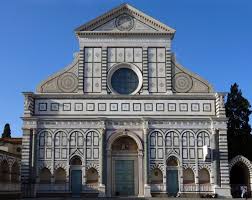
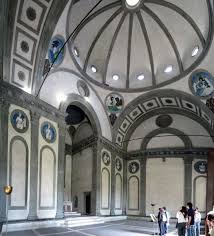
Pazzi Chapel
Basilicia di Santa Croce.
Florence, Italy.
Filippo Brunelleschi (architect)
c. 1429-1461 C.E.
Masonry
Harmonious proportions, inspired by Pantheon. Central dome is decorated with round sculptures and the coat of arms of Pazzi Family (commissioners). Corinthian columns, pendentives w/ roundels, small barrel vaults, dome w/ halo of windows & oculus.
Chapter house (meeting place for monks), burial site for Pazzi family, representation of power/devotion of Pazzi family

Arnolfini Portrait
Jan Van Eyck
Italian/Northern Renaissance
c. 1434 C.E.
Oil on wood
Van Eyck recognized as being one of the first to perfect use of oil paint. Shows a wife & husband with joined hands, dog = fidelity, lit candle = god’s presence, positioning of figures = reflective of roles in marriage, displays of wealth.
Documentation of a wedding.
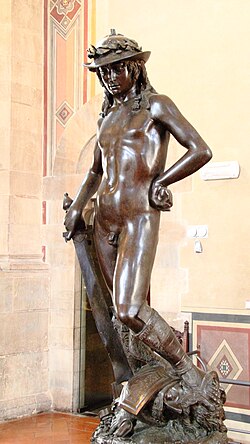
David
Donatello.
c. 1440-1460 C.E.
Bronze
Revival of classics - contrapposto stance, free-standing male nude. During middle ages, prioritization of god, nude seen as sinful. Reference to bible story of David and Goliath from the Old Testament. Subtle expression of pride.
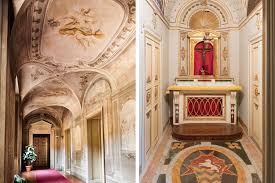
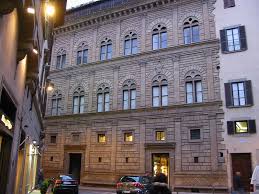
Palazzo Rucellai
Florence, Italy.
Leon Battista Alberti (architect).
c. 1450 C.E.
Stone, masonry
Uses architectural features for decorative purposes rather than structural support; like the engaged columns on the Colosseum, the pilasters on the façade of the Rucellai do nothing to support building. Design goes from least —> most decorative as ascend from lowest —> highest. Partly based on Medici palace. Inspired by Greek/Roman architecture.
To house the Rucellai family (had their seal). Demonstrates family’s wealth, status, power, & importance.

Madonna and Child with Two Angels
Fra Filippo Lippi.
c. 1465 C.E.
Tempera on wood
Commissioned by the Medici family, growing middle class, Florence was rich af. Playful, not solemn as traditional medieval
Demonstrated piety/wealth of Medici family. Used as a reminder of Christ’s story.
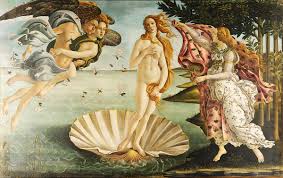
The Birth of Venus
Sandro Brotticelli.
c. 1484-1486 C.E.
Tempera on canvas
Botticelli = the first to create large scale mythology scenes, some based on historical accounts. In the era that Birth of Venus was painted, minds were open to new ideas and religion no longer needed to be the main subject of artistic work. If such mythological pieces had been painted 100 years earlier, they would not have been accepted by the church because they were so different to traditional depictions. Feeling of movement.
Mythological & educational purposes.

Last Supper
Leonardo da Vinci.
c. 1494-1498 C.E.
Oil and tempera
Not first depiction of Last Supper BUT first to shows disciples are displaying very human, identifiable emotions. Painted during the Renaissance. Linear perspective, strong sense of depth.
Monks would eat slightly in front of the painting for contemplation. Shows the flaws in humanity.
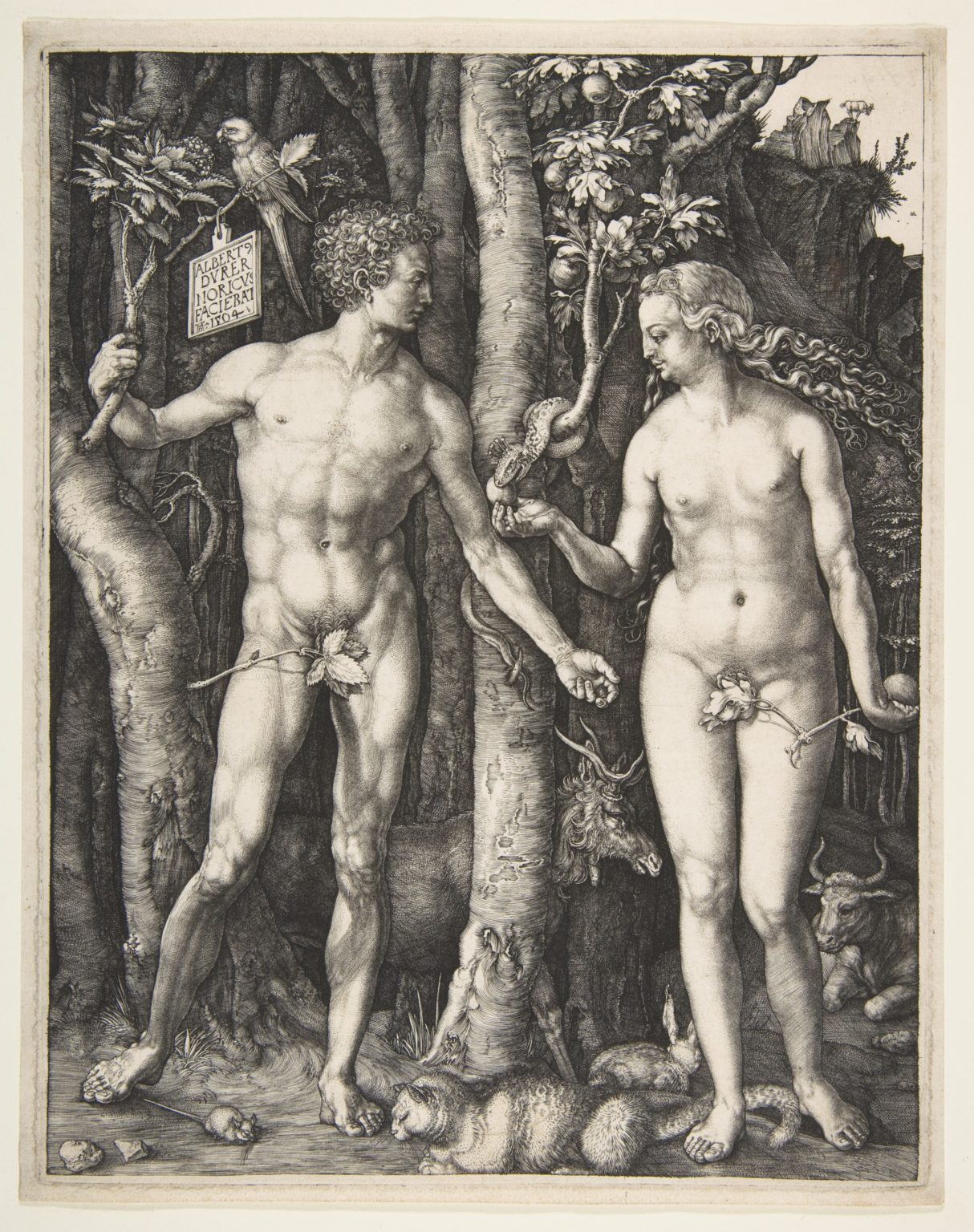
Adam and Eve
Albrecht Dürer.
1504 C.E.
Engraving
Dürer drawn to the idea that the perfect human form corresponded to a system of proportion and measurements. 4 animals in left corner symbolizing the 4 humours Phlegmatic (ox), Sanguine (rabbit), Melancholic (elk), and Choleric (cat). Parrot = wisdom/virgin birth of Christ/salvation, mouse = male weakness, goat = lust & damnation, serpent = evil
Tells story of Adam & Eve from the Bible
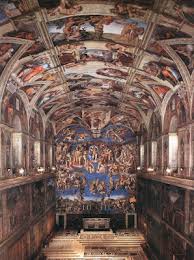
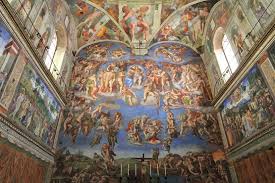
Sistine Chapel ceiling and altar wall frescos
Vatican City, Italy.
Michelangelo.
Ceiling frescoes: c. 1508-1512 C.E.; altar frescoes: c. 1536-1541 C.E.
Fresco
Depict 9 stories from the Christian Bible's Book of Genesis, inclu. the most famous image, the Creation of Adam (right). Influenced by Greek/Roman styles. Realistic figures & idealized beauty, emphasis on muscular autonomy.
Where the College of Cardinals determines the next pope. Tells stories of biblical events.
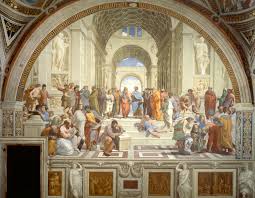
School of Athens
Raphael.
1509-1511 C.E.
Fresco
Pictorial concept, formal beauty and thematic unity. Embodies Renaissance ideals & the early cinquecento. Few years prior to Protestant reformation. Inspiration from Ancient Roman architecture. The four walls show the four branches of human knowledge (Philosophy, Theology, Poetry, and Justice). Ceiling modelled after Sistine Chapel. Plato, Aristotle, Euclid, Baramate.
Tribute to philosophers/thinkers of Rome. Aided to pass their knowledge down to the pope.
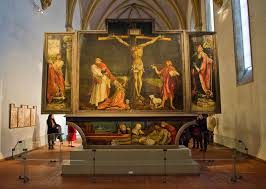
Isenheim altarpiece
Matthias Grünewald.
c. 1512-1516 C.E.
Oil on wood
Emphasizes the suffering and anguish of Christ and his mother's angst. Intense colors and dramatic lighting.
Object of devotion. Fully opened only on special occasions.

Entombment of Christ
Jacopo da Pontormo.
1525-1528 C.E.
Oil on wood
Flattened space, sculptural congregation of brightly demarcated colors. The vortex of the composition droops down towards the limp body of Jesus off center in the left. Those lowering Christ appear to demand viewer’s help in sustaining both the weight of his body (and the burden of sin Christ took on) and their grief
Altar piece
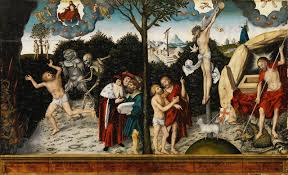
Allegory of Law and Grace
Lucas Cranach the Elder.
c. 1530 C.E.
Woodcut and letterpress (later oil on wood?)
Made during Northern Renaissance & influenced by Lutherian reform. Belief that heaven is reached through faith & god’s grace, rejection of concept that good deeds could earn heaven. Law (left) = dying tree, Gospel (right)=living tree. Includes events form Old & New testament.
To spread Lutherian reformation
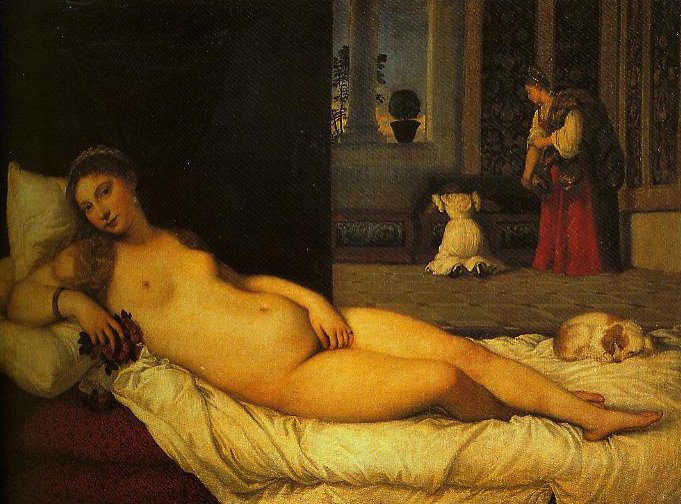
Venus of Urbino
Titan.
c. 1538 C.E.
Oil on canvas
Use of color and its contrasts, & the subtle meanings and allusions, —> represents the perfect Renaissance woman who, like Venus, = symbol of love, beauty and fertility. Ventian art (mvmt of art in Venice), deep colours, use of shadows/light. Dog = fidelity, child & maid = motherhood. Venice @ time had lots of trade allowing investors in art.
Duke Urbino Guibaldo II Della Rouvre gave painting as a gift to his wife. Shows how wife should treat the husband (sexually & respectfully)
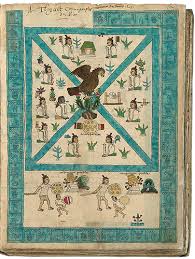
Frontispiece of the Codex Mendoza
Viceroyalty of New Spain.
c. 1541-1542 C.E.
Ink and color on paper
Codex contains info. abt the Aztec empire & lords of Tenochtitlan. Depicts Aztec myth of the hummingbird (deity that told ancestors to move from Aztlan —> build a city at place w/ an eagle on top of a cactus growing out of a rock)
Emphasized power of the Aztecs. Tribute to the Aztecs.
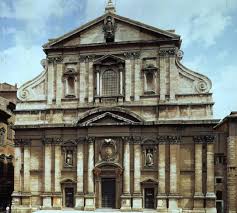

Il Gesù, including Triumph of the Name of Jesus ceiling fresco
Rome, Italy.
Giacomo da Vignola, plan (architect); Giamcomo della Porta, facade (architect); Giovanni Battista Gaulli, ceiling fresco (artist).
Church: 16th century C.E.; facade: 1568-1584 C.E.; fresco and stucco figures: 1679-1679 C.E.
Brick, marble, fresco, and stucco
Large central nave with the laterally placed pulpit = auditorium for preaching, highly visible altar = theatrical stage for the celebration of the Real Presence in the Eucharist. Saint Ignaticus Loyola (found of Jesuit faith) needed religious centre, Gesu = mother church. Crucifix floor plan.
Original church for the Jesuits. Illustrated beliefs of the Jesuits.

Hunters in the Snow
Pieters Bruegel the Elder.
1565 C.E.
Oil paint on wood panel
Secular painting. 1/6 works called Months of the Year. Northern Renaissance. Hunters returning from an unsuccessful hunt. Contrasting colours, contrapposto, sharp forms.
Represents hardships/enjoyments of winter. Showcases everyday activities.
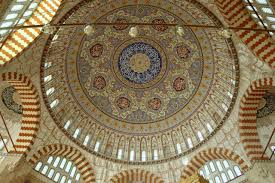
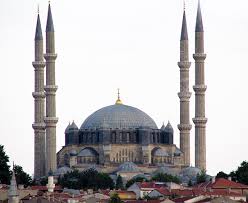
Mosque of Selim II
Edrine, Turkey.
Sinan (architect)
1568-1575 C.E.
Brick and stone
Patroned by Sultan Selim II during the classical Ottoman period. Etherial dome which appears to float in the prayer hall. Painted interior, iznik tiles, chinese cloud art, polychrome. Lots of windows.
Made to show wealth/greatness of the Ottoman Empire

Calling of Saint Matthew
Caravaggio.
c. 1597-1601 C.E.
Oil on canvas
Counter-reformation (catholic church reacting against protestant reformation). Baroque style (theatrical action, diagonal lines, gritty realism). Biblical story of the calling of Saint Matthew. Jesus’s hand mimics the Michelangelo’s hand of God in “The Creation of Adam”.
Located in Contarelli Chapel, Rome. Didactic element (portrays story as taught from the catholic perspective). Makes the viewer experience the painting the “catholic way”
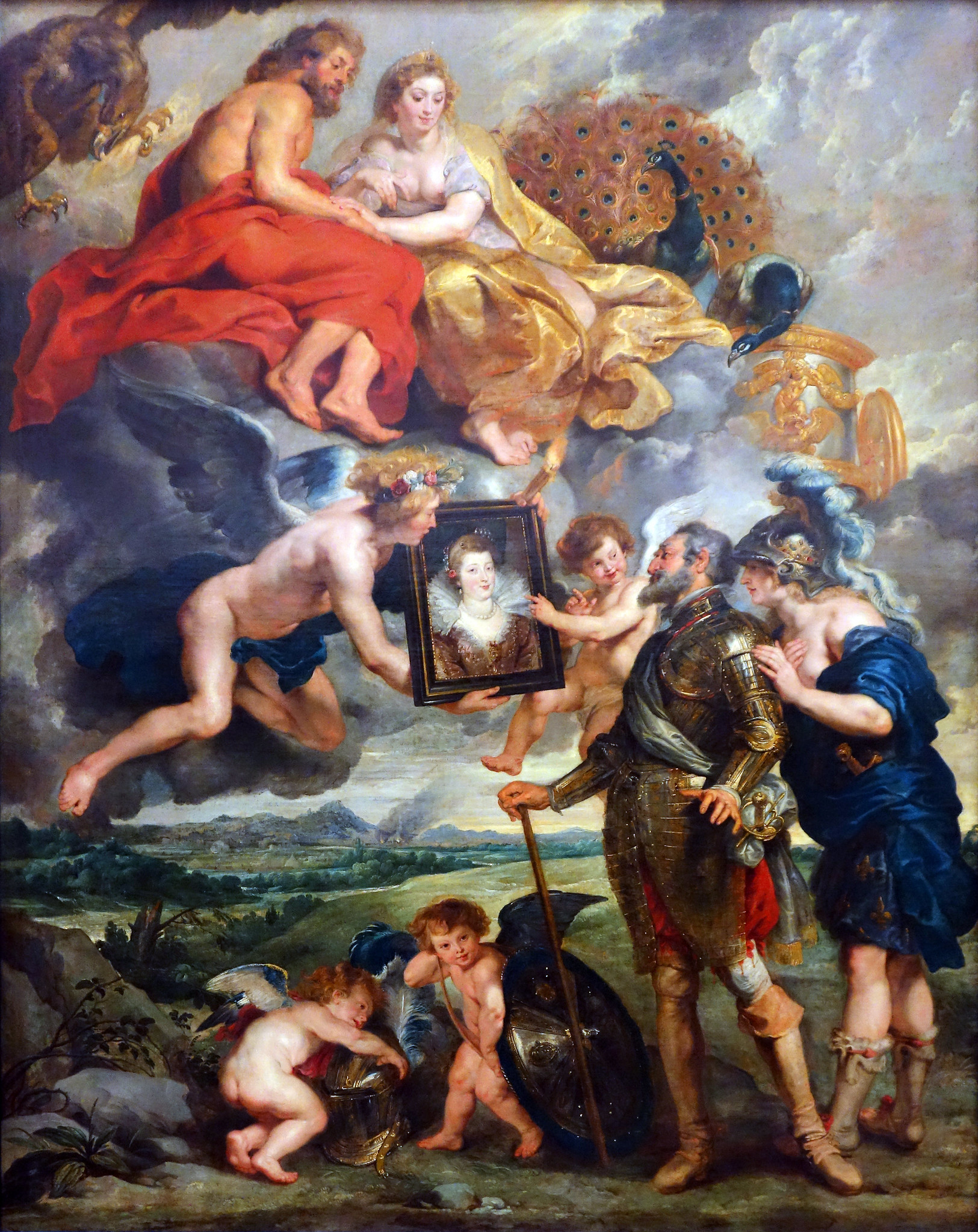
Henri IV Recieves the portrait of Marie de' Medici, from the Marie de' Medici Cycle
Peter Paul Rubens.
1621-1625 C.E.
Oil on canvas
Inspired by Titan from the Renaissance period. 6/24 paintings. Divisions among the French court earlier led to King Henry IV’s assassination and Marie’s exile, this painting made as propaganda. Depicts deities of marriage (hymen on left) and marriage (cupid on right). Personification of France encouraging Henry to marry Marie for political purpouses
Used for propoganda, political/religious meaning
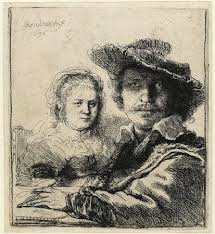
Self-Portrait with Saskia
Rembrandt van Rijn.
1636 C.E.
Etching
Rembrandt = known for etchings, experimental artist. Portrait of Rembrandt and his wife after they married. Illusion of depth with body placement.
Functioned as a private artwork.
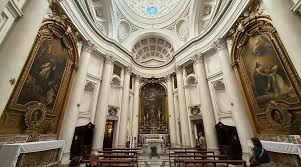
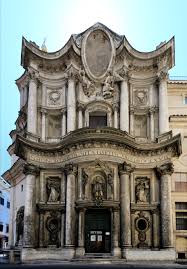
San Carlo alle Quattro Fontane
Rome, Italy.
Francesco Borromini (architect)
1638-1646 C.E.
Stone and stucco
Baroque style (undulating mvmts and sculptural effects). Borromini suffered from melancholia. Central niche above portal contained a statue of St Charles Borromeo & founder of Trinitarian order. Facade with 3 bays. Inspo from Greek architecture.
Dedicated to St Charles Borromeo and the Holy Trinity
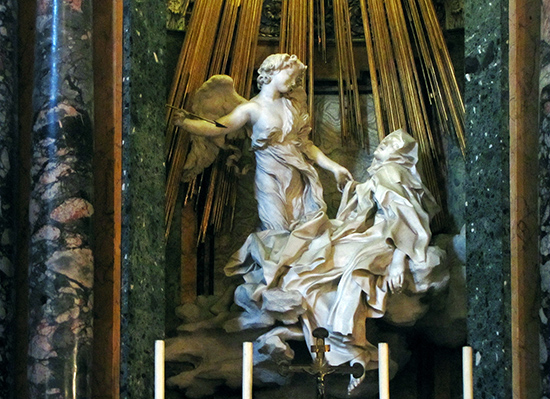
Ecstasy of Saint Theresa
Cornaro Chapel, Church of Santa Maria della Vittoria
Rome, Italy.
Gian Lorenzo Bernini.
c. 1647-1652 C.E.
Marble (sculpture); stucco and gilt bronze (chapel)
Baroque period. Subject = Saint Teresa of Avila. Rays of gold = holy light of god. Moment of ecstasy = spiritual awaking.
Served as a visual representation of Saint Teresa when she was brought to god.
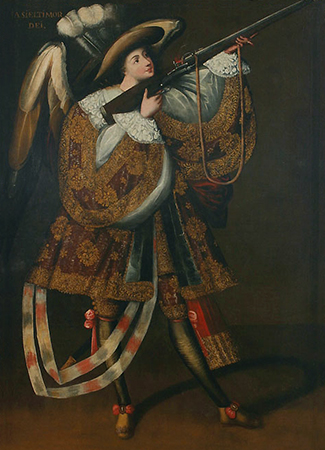
Angel with Arquebus, Asiel Timor Dei
Master of Calamarca (La Paz School).
c. 17th century C.E.
Oil on canvas
Made in viceroyalty of Peru after the first missionizing period (attempting to convert Indigenous to Christianity) and was likely part of a series.
Made to represent celestial, aristocratic and military beings. Represented power/connection to god/political power of the Spanish government
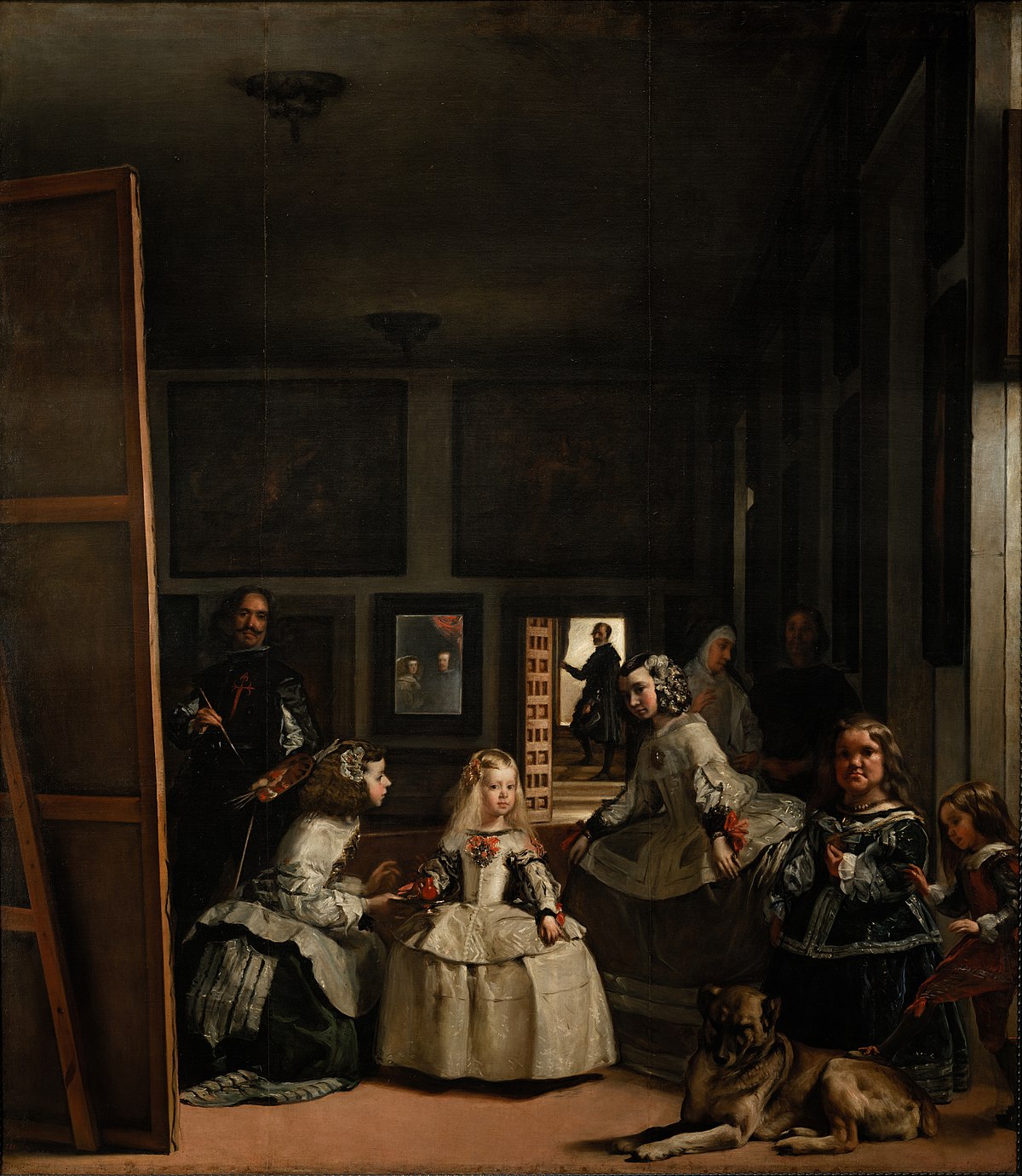
Las Meninas
Diego Velázquez.
c. 1656 C.E.
Oil on canvas
Used to be housed in the royal palace called Royal Alcazar of Madrid. To compensate for the family’s incest they were painted in elaborate clothes. Velazquez = court artist. Painting of Ovid’s the metamorphosis hangs in the background ( story of gods wrestling with mortals). In the center is the princess, maids of honor, palace of official, chaperone, dog, dwarf (hired to be friends with the children), and other attendant
Made for the King and queen to view. To show ethereal perfection, wealth, but showed some informal aspects

Woman Holding a Balance
Johnnes Vermer
c. 1664 C.E.
Oil on canvas
Baroque period. Balance = central focus, emphasizes the weighing of transitory material concerns against spiritual ones. Vermeer trained w/ a master painter in a guild. Painted in the year prior to the second Anglo-Dutch war. Woman part of the upper merchant class, her head divides the blessed and the damned in painting of the Last Judgement behind her.
Showed wealth & piety (worldly possessions and Christ in the back). Sign of self knowledge and truth.
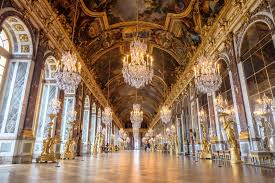
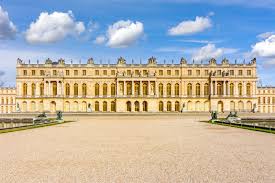
The Palace of Versailles
Versailles, France.
Loius Le Vau and Jules Hardouin-Mansart (architects).
Begun 1669 C.E.
Masonry, stone, wood, iron, and gold leaf (architecture); marble and bronze (sculpture); gardens
Satellite city to the East of the palace, housed a court and government officials, military and guard detachments, courtiers, and servants. Extremely detailed & ornate. Hall of Mirrors used for festivals and parties. City’s 3 main avenues axis converged at the King’s bedroom, so he can keep an eye on high ranking officials and the king’s bedroom was an informal audience room.
Emphasized the importance/power of King Louis XIV. Used to host parties and military agreements. To compared the king’s wisdom to Apollo. Symbolized power of an absolute monarch.
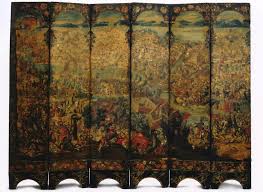
Screen with the Siege of Belgrade and hunting scene
Circle of the González Family.
c. 1697-1701 C.E.
Tempera and resin on wood, shell inlay
Spanish piece. Only known artwork that combines biombos and encapuchados. Depicts the Battle of Belgrade (1688). Influenced by Japanese folding screens (New Spain was in trade with Japan). Throughout both sides, the artists embedded thin layers of mother-of-pearl, but not in any pattern, nor within the images' contour lines. Their purpose was to reflect light from the candles that would have shone in the screen's surroundings
To be placed in the viceroy's palace as a decorative piece. Intended to be viewed by two different audiences
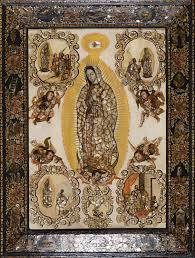
The Virgin of Guadalupe
Miguel González.
c. 1698 C.E.
Based on original Virgin of Gaudalupe.
Basilica of Guadalupe, Mexico City.
16th century C.E.
Oil on canvas on wood, inlaid with mother-of-pearl
Created during Spanish colonization/missionary period. Virgin of Guadalupe thought to have stopped the flooding of Mexico city. Iridescent surface suggests heavenly/divine.
For religious purposes and dedication.
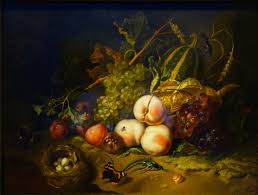
Fruit and Insects
Rachel Ruysch.
1711 C.E.
Oil on wood
Made during the Renaissance. Ruysch = first succeeding female artist in Baroque period & specialized in still life, grapes represent blood of christ, animals = naturalism. Represents at least two passions of its time: categorization and still-life, which emphasize the pleasure of the senses and their qualities
For Rachel Ruysch Cosimo II = a sign of friendship and commonwealth. Was sold. Painting was for widening merchant class
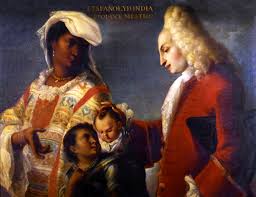
Spaniard and Indian Produce a Mestizo
Attributed to Juan Rodríguez Juárez.
c. 1715 C.E.
Oil on canvas
The painting displays a Spanish father and Indigenous mother with their son, and it belongs to a larger series of works that seek to document the inter-ethnic mixing occurring in New Spain among Europeans, indigenous peoples, Africans, and the existing mixed-race population. Casta painting- focus on bad living conditions for families that are mixed racially.
Made to discourage racial mixing bc dark skin considered dirty, unattractive, uncivilized. Tries to show european blood as superior.
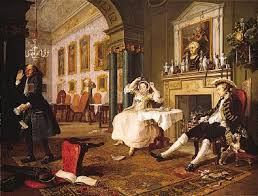
The Tete a Tete, from Marriage à la Mode
William Hogarth.
c. 1743 C.E.
Oil on canvas
2/6 series of paintings. The story revolves around a marriage of the daughter of a merchant to the son of a popular family (works are know altogether as Marriage a la mode). Set during the industrial revolution. Aristocracy began losing power to merchants. LOTS of symbolism to infidelity.
Satirical commentary. Appeal to middle class.
First Western artist who worked in series, that is, a group of paintings with a common thread, a common theme. Now many contemporary artists work in series to explore different styles and approaches to their art, but this was not usual in the 18th century.
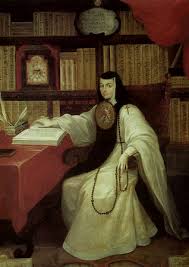
Portrait of Sor Juana Inés de la Cruz
Miguel Cabrera.c. 1750 C.E.
Oil on canvas.
Neoclassical. Sor Juana = 1st feminist in the Americas, pursuing her own interests, engaging in debates w/ philosophers and scientists, choosing to become a nun. Church concerned by outspokeness abt women’s rights and forced her to sign an agreement to no longer pursue intellectual interests. She later died of a disease. Red curtains = common in paintings of elites. Religious garments = devotion to God. Books to show intellectual interest.
Portrait for Sor Juana
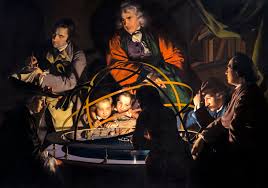
A Philosopher Giving a Lecture on the Orrery
Joseph Wright of Derby.
England
c. 1763-1765 C.E.
Oil on canvas
Midst enlightenment mvmt. Joseph = unofficial artist of the time, known for use of chiaroscuro. Depicts a scientist, note-taker, and child around a Orrery (mechanical model of solar system). Meant to depict actual ppl, although we don’t know who. Strong internal light symbolizes enlightenment rational thinking.
To showcase significant scientific improvements during the enlightenment. To show curiosity/knowledge gained.